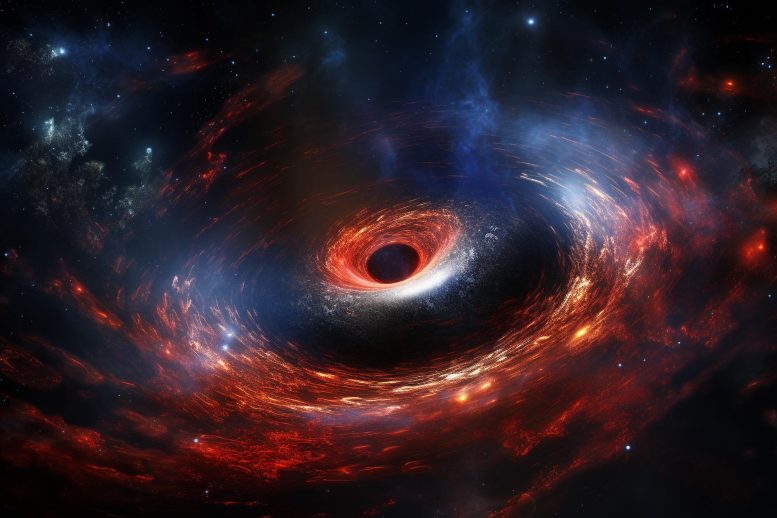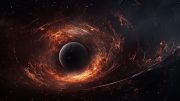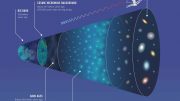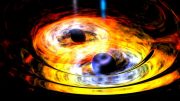
The James Webb Space Telescope has discovered the furthest active supermassive black hole yet, situated in the CEERS 1019 galaxy, which is less massive than any other black hole identified from the early universe. The findings, which also include the detection of two more smaller black holes and eleven early universe galaxies, could revolutionize our understanding of black hole formation and the evolution of the cosmos.
The James Webb Space Telescope has uncovered the most remote active supermassive black hole known to date, situated in the galaxy CEERS 1019, which existed about 570 million years after the Big Bang.
Researchers, using the James Webb Space Telescope (JWST), have identified the farthest active supermassive black hole ever recorded. Located in galaxy CEERS 1019, this black hole was active about 570 million years following the Big Bang and is unique in that it is smaller than any other discovered from this early epoch of the universe.
In the study, two more black holes, smaller than usual, were found to have existed approximately 1 billion and 1.1 billion years after the Big Bang. Along with these, JWST has identified eleven galaxies from a time when the universe was between 470 million and 675 million years old. The discoveries were made possible through the Cosmic Evolution Early Release Science (CEERS) Survey Survey, helmed by Steven Finkelstein, an astronomy professor at The University of Texas at Austin. The survey used JWST’s high-resolution near- and mid-infrared imagery and spectral data to inform their findings.
“Looking at this distant object with this telescope is a lot like looking at data from black holes that exist in galaxies near our own,” said Rebecca Larson, a recent Ph.D. graduate at UT Austin, who led the study. “There are so many spectral lines to analyze!”
The team has published these results in several initial papers in a special edition of The Astrophysical Journal Letters.
CEERS 1019 is significant not just because of its antiquity but also due to the relatively low mass of its black hole. It weighs in at around 9 million solar masses, significantly less than other black holes from the early universe detected by other telescopes. These other black holes, typically boasting over 1 billion times the mass of the sun, are easier to spot because of their brightness. The black hole in CEERS 1019 is more akin to the black hole at the center of our own Milky Way galaxy, which is 4.6 million times the mass of the sun.
Puzzling Existence and Formation
The presence of this relatively small black hole so early in the universe’s timeline poses interesting questions about how it formed so rapidly after the universe’s inception. It has been a longstanding belief among researchers that smaller black holes would have existed in the early universe, but solid evidence was not available until JWST began its observations.
Probing the Black Hole and its Galaxy
The research team was able to decipher which emissions in the spectral data were from the black hole and which were from its host galaxy. They were also able to estimate the rate at which the black hole was ingesting gas and ascertain the star-formation rate of its galaxy.
The team discovered that this galaxy is consuming gas at the highest rate possible while simultaneously producing new stars. The images reveal that CEERS 1019 visually appears as three bright clumps rather than a single circular disk.
“We’re not used to seeing so much structure in images at these distances,” said CEERS team member Jeyhan Kartaltepe, an associate professor of astronomy at the Rochester Institute of Technology in New York. “A galaxy merger could be partly responsible for fueling the activity in this galaxy’s black hole, and that could also lead to increased star formation.”
A New Era for Astronomical Research
These findings mark only the first breakthroughs from the CEERS Survey.
“Until now, research about objects in the early universe was largely theoretical,” Finkelstein said. “With Webb, not only can we see black holes and galaxies at extreme distances, we can now start to accurately measure them. That’s the tremendous power of this telescope.”
Future research may use JWST’s data to explain how early black holes formed, revising current models of black hole growth and evolution in the first several hundred million years of the universe’s history.
The James Webb Space Telescope is an international program led by NASA with its partners, the European Space Agency (ESA), and the Canadian Space Agency.
More Discoveries on the Horizon
The expansive CEERS Survey promises much more to explore. Dale Kocevski of Colby College in Waterville, Maine, along with the team, identified another pair of small black holes in the data quickly. The first one, in galaxy CEERS 2782, was easily identifiable. Its black hole was determined to exist about 1.1 billion years after the Big Bang as no dust obscured JWST’s view. The second black hole, in galaxy CEERS 746, existed slightly earlier, 1 billion years after the Big Bang. Its bright accretion disk, a gas and dust ring encircling its supermassive black hole, is partially shrouded by dust.
“The central black hole is visible, but the presence of dust suggests it might lie within a galaxy that is also furiously pumping out stars,” Kocevski explained.
Like the one in CEERS 1019, the two other newly described black holes (in galaxies CEERS 2782 and CEERS 746) are also “light weights” – at least when compared with previously known supermassive black holes at these distances. They are only about 10 million times the mass of the sun.
“Researchers have long known that there must be lower mass black holes in the early universe. Webb is the first observatory that can capture them so clearly,” Kocevski said. “Now we think that lower mass black holes might be all over the place, waiting to be discovered.”
Before JWST, all three black holes were too faint to be detected.
“With other telescopes, these targets look like ordinary star-forming galaxies, not active supermassive black holes,” Finkelstein added.
Measuring the Distant Universe
The sensitivity of JWST’s spectral analysis enabled the researchers to measure the precise distances and hence the ages of galaxies in the early universe. Team members Pablo Arrabal Haro of the National Science Foundation’s NOIRLab and Seiji Fujimoto, a postdoctoral researcher and Hubble fellow at UT Austin, identified 11 galaxies that existed 470 million to 675 million years after the Big Bang. These galaxies are not just extremely distant, but their brightness, given the large number detected, is also noteworthy. This challenges the theory that JWST would detect fewer galaxies at these distances.
“I am overwhelmed by the amount of highly detailed spectra of remote galaxies Webb returned,” Arrabal Haro said. “These data are absolutely incredible.”
Future Understanding of Galaxy Evolution
These galaxies are rapidly forming stars but have not yet accumulated the same chemical complexity found in closer galaxies.
“Webb was the first to detect some of these galaxies,” explained Fujimoto. “This set, along with other distant galaxies we may identify in the future, might change our understanding of star formation and galaxy evolution throughout cosmic history,” he added.
For more on this discovery, see Webb Detects Most Distant Active Supermassive Black Hole.
The team published several initial papers about CEERS Survey data in a special edition of The Astrophysical Journal Letters on July 6: “A CEERS Discovery of an Accreting Supermassive Black Hole 570 Myr after the Big Bang: Identifying a Progenitor of Massive z > 6 Quasars,” led by Larson, “Hidden Little Monsters: Spectroscopic Identification of Low-Mass, Broad-Line AGN at z > 5 with CEERS,” led by Kocevski, “Spectroscopic confirmation of CEERS NIRCam-selected galaxies at z≃8−10,” led by Arrabal Haro, and “CEERS Spectroscopic Confirmation of NIRCam-Selected z ≳ 8 Galaxy Candidates with JWST/NIRSpec: Initial Characterization of their Properties,” led by Fujimoto.









WADR,
To post the headline, the oldest active black hole in the universe, would be a little misleading wouldn’t it?
This is an excellent site, better than most. Why muck it all up with sensationalism. I mean, as far back as web can see, there’s still a lot out there much further back. That’s evident by the images of webs limit. So, the 13 and some billion years also seems to be a questionable age. It looks as if there is no center of the universe, anywhere the telescope is pointed, it’s the same. It’s also unfortunate that science sometimes pushes a theory as fact, theoretical doesn’t mean an absolute, It means a possibility or opinion. Let’s just call it what it is, a new discovery.
Ok
I agree with the beautifully expressed comment above……the Big Bang is touted as fact by so many…..yet ….absolutely no proof….and, we are scorned for the creationist point of view…..why ???
So many things the science community takes as fact, is laughable!!! Take carbon dating, any elementary science kid tells u when u do a science experiment u need a con trolled environment!!! We really have absolutely no idea of the carbon 1/2 life of a sample, you would need to know the exact everything(that can cause different rates of carbon half life’s evaporation) I hope I used the right words
How can scientist find the evolutionary origins of masterbation, that’s just someone feeding his or hers EGO PROBLEM THAT IS WAY OUT OF CONTROL!!
Beautiful